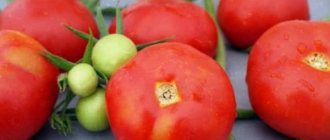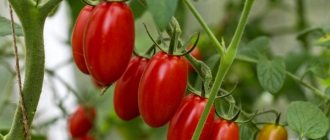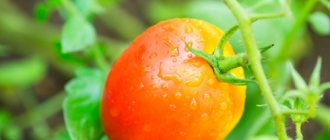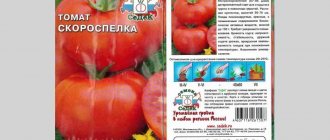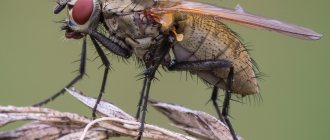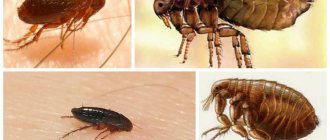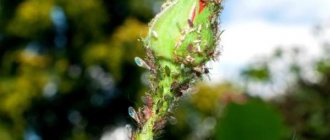Description of the variety
The work of hybridization is a complex process. Tomato “Treasure of the Incas f1” was no exception. For several years, step by step, breeders have been trying to take the best from the parent pairs in order to give the world a masterpiece. And they succeeded.
- author of the hybrid Kiramov A.D.;
- originator - Belokin-Mechtalin V.I.;
- The applicant of the variety is LLC TK Leader, Moscow.
Description of the bush and fruit
“Treasure of the Incas” is stated as a first generation hybrid. This means that there is no point in collecting seeds from tomatoes for further reproduction. However, having sowed them and grown a tomato, the vegetable grower realizes that there is no point in wasting money on seeds - they are worth it.
The hybrid is indeterminate. Its growth does not end with a flower brush, but continues until a person finishes it by biting the top. The bush itself, when formed into one shoot, is not particularly different from other varieties and hybrids.
- height - up to 2 meters;
- leaf - medium size;
- leaf color is deep green;
- inflorescence - simple.
Early ripening hybrid. Having sowed seedlings in early March and received quick shoots, the plant grows intensively, rushing to please the vegetable grower with its first fruits.
Indeed, there are not many large-fruited hybrids and especially varieties that can quickly:
- increase vegetative mass;
- produce an ovary;
- grow a large fruit;
- accumulate the optimal amount of sugar.
As the reviews say, “Treasure of the Incas” can. 90-95 days after full germination in the greenhouse, the plant already produces the first salad tomato. The fruit is flat-round, classic in shape. It feels dense to the touch. By taking it in your hand, you can clearly feel the weak rib, although it is not noticeable when contemplating it. It's all about the color.
The unripe fruit is no different. It is green without pronounced dark greenery at the stalk. The shape, even of the ovary, is seen as flat-round. She is growing quickly and gaining weight. The tomato grows, comes into color and it becomes clear that it will not be ordinary. The colors are not uniform and spread out in stripes and spots all over the tomato. Reds turn to orange and yellow. Such tomatoes are called “marble” or bicolor. But the variety register describes them as orange-red. The weight of average fruits is within 240-250 g.
Taste qualities of fruits
The fruit of the “Treasure of the Incas” tomato is pleasant to look at and elastic. Trying to inhale the aroma, you feel a light veil of nightshade scent.
The beauty of a tomato is enhanced when it is cut into two halves. The orange marbling extends to the flesh. Seed nests are difficult to see due to their dense texture; there are 4-6 of them. There are few seeds and they are in the “body” of the pulp.
Having passed the tests, the tasting commission in all regions of the country gave the tomato an “excellent” rating. This suggests that the hybrid can accumulate sugars under different weather conditions. Organic acids are so balanced in the fruit that the sourness becomes pleasant and almost imperceptible.
Not everyone likes sweet tomatoes. However, when sugars and acids have an optimal ratio, the tomato acquires an unforgettable taste.
What the Incas looked like. Government of the Inca Empire
A large state needs competent administrative management. The conquerors divided all the conquered lands into four provinces: Kuntisuyu, Kolyasuyu, Antisuyu and Chinchasuyu. In the center of Cusco was Huacapata Square. From it, in different directions, four roads diverged, leading to these administrative formations of the empire.
The Incas loved and knew how to build roads. They made them wide with an even surface. The longest stretched for 5250 kilometers and had a width of 7.5 meters. True, the Indians did not know the wheel, so they moved along such highways on foot; the load was carried on oneself or transported on llamas.
The great conquerors did not know any written language, but despite this, the state postal service worked perfectly. Numerous messengers constantly hurried to different parts of the empire and conveyed decrees and regulations through “knot letters” or orally.
The Incas had well-developed agriculture, animal husbandry, and handicrafts. There was no single monetary standard. The process of buying and selling took place between seller and buyer at numerous fairs through the exchange of goods. Such fairs, as a rule, were held in cities at least once every ten days.
There was no obvious division of society into rich and poor. Everyone's standard of living was approximately the same. The bulk of the population lived in tribal communities - ailyu. A separate family had a land plot - topu. Each member of society bore a labor obligation—mita. Important issues of public life were resolved at general meetings - kamachiko.
The Incas came up with the idea of enlisting in the army at the age of 18
When a man reached the age of 18, he was drafted into military or courier service. Her sentence lasted 7 years. Every resident of the country had to go through this. Then, after the end of the seven-year period, the man became purekhi. This was the name given to people who worked for public needs and paid taxes. After 50 years, a person moved to another age category and began raising children.
In a great empire, any resident could achieve a high position in society. The main thing was not origin, but services to the empire. An experienced warrior or talented speaker enjoyed universal respect and veneration, regardless of who his parents were.
The supreme power in the country was inherited. The one who ascended the throne received the prefix “Inca” to his name. In a narrow sense, it meant the title of a ruler, like a king or emperor in Europe. Also called Incas were full members of the Cusco community, who were descendants of an ancient tribe that recognized the power of the children of the Sun God Inti. They were, as it were, considered “Inca by blood.”
Characteristics of the variety
This tomato, despite the high cost of the seed material, is a must-try. A promising hybrid will give the vegetable grower a good harvest of tasty fruits.
Advantages and disadvantages
The “Treasure of the Incas” tomato is included in the register of breeding achievements of the Russian Federation with the following characteristics:
- first generation hybrid;
- early ripening;
- indeterminate;
- salad;
- large-fruited;
- orange-red color.
It is difficult to judge which of the above is an advantage and which is a disadvantage. Each vegetable grower selects hybrid varieties to suit their growing conditions.
But the yield indicators are impressive. According to reviews from those who have already planted the hybrid, it has the following advantages:
- heat resistant;
- lightweight;
- does not crack;
- has excellent transportability.
Productivity
The hybrid was assigned an average yield of 16-18 kg per m2. This is an excellent indicator. Such results can be achieved when grown in a greenhouse. In the garden, of course, the gross harvest may be lower. However, given the early ripeness, it is quite possible to harvest such a crop on a personal plot.
Advice. Whatever the genetic potential of the hybrid, nutrients are needed for yield. Don't deny the plant this.
The hybrid is very responsive to:
- regular watering;
- timely root feeding;
- foliar spraying.
Fertile soils allow you to get an excellent harvest of delicious tomatoes.
Area of application of fruits
The hybrid “Treasure of the Incas” is served as a salad. The fruits have a dense skin, and the pulp itself is cut very evenly and neatly. The peel perfectly holds the shape of the bars and layers. At the same time, it is quite eatable.
Since seeds are expensive, it is not at all profitable to process such fruits. But the yield is high and when planting 10 bushes there will certainly be a surplus. You can make tomato juice from them. The product turns out:
- thick;
- sweet;
- saturated.
However, there is a drawback to processing - color. Since the fruits are orange, the juice is somewhat pale. You can correct the situation by adding other varieties of tomatoes. At the same time, the taste will also change, but will not become worse.
Resistance to diseases and pests
The variety register lists the hybrid “Treasure of the Incas” as moderately resistant to tomato diseases. If it is grown in a greenhouse, then it is possible to regulate humidity and temperature. At the same time, late blight cannot cause harm.
A vegetable garden is a completely different matter, especially in those regions where:
- the heat gives way to coolness;
- there is a high probability of prolonged rains;
- Autumn is coming quickly with cold nights.
Under such cultivation conditions, prevention is the only method to obtain a harvest.
The world has long learned to prevent the action of the fungus that causes late blight. 2-3 treatments with fungicides are enough and the harvest will be saved.
describes the variety as super resistant to many diseases. However, reviews from gardeners show that this is not always the case.
Growing regions
Having entered the variety testing “Treasure of the Incas”, it took two years to pass them through all regions of the country. And in 2022 it was successfully registered and recommended for cultivation throughout the country for:
- vegetable gardens;
- personal plots;
- summer cottages and greenhouses.
The tomato is so flexible that it can adapt and gain sugar content even under not entirely favorable conditions in mid- and northern latitudes.
Features of cultivation
The “Treasure of the Incas” tomato is also called the “Gold of the Incas” for its unpretentiousness. The author really tried.
Landing rules
Early tomato. If you are planning a greenhouse, then March 1 to 5 are quite normal dates for sowing warmed and sprouted seeds. In this case, shoots will appear by March 20. If the greenhouse is heated, it can be done earlier.
For quick germination, do this:
- seeds are placed in a damp cloth;
- wrapped in a plastic bag;
- put in a warm place.
After 3 days the result is visible.
By this time, the tubs need to be filled with soil for seedlings. It must be warmed up and compacted. Lay out the seeds and sprinkle with soil. We water with warm water. Let's create a greenhouse. For this you can use:
- special tubs for seedlings with a transparent lid that creates a greenhouse effect;
- plastic film or bag;
- glass.
The place of germination may be dark, but it must be warm. Tomato is heat-loving. Its seeds are able to germinate at temperatures above 22 ᵒC.
The first shoots will be visible in 5-6 days. After another 4-5 days, when 70% of the seeds have sprouted, the cover can be removed.
Transplanting seedlings
If the sowing was done in a common tub, then replanting is carried out when the seedlings grow a pair of true leaves. This is the moment of the dive. This period is very important for the “Treasure of the Incas” hybrid. An early tomato needs a quick start for a quick harvest. That is why it is necessary to dive into individual containers with a volume of at least 0.5 liters.
Advice. Dive into individual containers. A closed root system when transplanted to a permanent place will allow the plant not to stop developing and time will not be lost.
After transplanting into glasses, they will require from the grower:
- regular watering with water draining into the pan;
- air temperature at night 16-17 ᵒC;
- warming during the day at a temperature of 22-23 ᵒC;
- the brightest place on the windowsill.
At the age of 55-65 days, the seedlings will be strong and stocky. It is ready for transplanting into a greenhouse and open ground.
With a closed root system, replanting proceeds without problems. If she stretches out a little, then she is planted deeper. To do this, dig a larger hole, and the capacity of the glass is planted there using the transfer method.
Watering and fertilizing
The “Treasure” waterings do not have any special features. They should be carried out:
- regularly, depending on the heavenly moisture;
- warm water;
- volumetrically, so that after watering the entire root system is in moist soil.
Fertilizers for productive and large-fruited hybrids are very important, especially if soil fertility is in question.
You need to start feeding planted tomatoes after 15-20 days. To do this, you can use a solution of manure from cattle, pigs, horses, or chicken droppings. Organic, excellent, balanced nutrition. Prepare fertilizing “compote” as follows:
- 1 kg of manure or 0.5 kg of chicken droppings is sent into a bucket;
- fill with water;
- stir;
- leave to saturate for 1 day.
This fertilizer is quite concentrated. You can’t apply it directly to the root. It should be dissolved in irrigation water. To do this, take 1 liter of nutrient solution per bucket of water and mix it with irrigation water. Apply half a liter to each bush.
Feeding should be done every 12-15 days. Such an event will ensure balanced nutrition of the bush and an optimal set of vegetative mass.
Pinching and tying
It is better to lead the Inca treasure in one escape. To do this, you need to regularly remove all stepsons. You should not let them outgrow; they draw nutrients onto themselves.
The best time for pinching is a size of 1-2 cm. At this age, the tissues are tender, pliable, and easy to pinch off directly with a fingernail. As the stepson grows, it becomes denser and then they resort to using scissors or a knife.
If there are few seedlings, then the lowest stepsons can be grown to 5-6 cm, cut off and rooted in water.
As the shoot grows, it needs to be tied to supports. The stem should not be allowed to bend under the weight of the fruit.
Formation
The southern regions can afford to form a hybrid in two shoots. To do this, leave one stepson, which is formed above 7-8 leaves. The remaining stepsons are removed.
The northern regions also carry out the formation of two shoots in heated greenhouses. If a tomato is planted in open ground, then only in one shoot.
Advice. Soberly assess the nutritional value of the soil. If they are not very fertile, then cultivate only one shoot.
Tomato care
The Incan treasure needs regular:
- watering;
- feeding;
- bush formation;
- fixation of shoots.
If nature sets up a test of endurance and the plant gives only a bouquet of yellow flowers, you need to help it. Apply foliar feeding.
For better formation of the ovary, you need to treat the buds and young ends of the stems with a solution of boric acid. To do this, prepare a nutrient preparation from 0.5 g of boric acid and one liter of water. Spraying is best done in warm, sunny weather.
Agricultural technology of tomatoes Treasure of the Incas
If you take into account the agricultural technology of growing a crop, then it is worth taking into account the fact that you need to sow the seeds 60 days before the expected time of planting the seedlings in the beds. Seedlings are picked after 2 or more leaves have appeared on the tomato bushes.
When planting tomato bushes in a permanent place of growth, it is necessary to use a planting scheme. Thus, for every sq. m it is recommended to plant up to 3 bushes, a maximum of 4 bushes if the formation was carried out in 1 stem.
Further care of the crop involves timely watering, removing weeds, applying fertilizers, loosening the soil, pinching and preventive measures, thanks to which the appearance of many types of diseases and pests can be prevented.
Landing rules
After the seedlings have grown to the desired size, they should be transferred to open ground or a greenhouse. It is recommended to adhere to the following scheme:
- in open ground it is allowed to plant up to 3 bushes per 1 square meter. m;
- in the greenhouse - 4 tomato bushes per 1 sq. m.
After the planting material has been planted, it is recommended to water the crop under the stem. In order for the plants to adapt faster and better, it is recommended to cover the plantings with polyethylene for several days.
Diseases and pests
The Inca Treasure does not show increased resistance to any diseases, everything is at an average level. Therefore, prevention and protection are needed.
Protection from diseases and pests
Tomato pathogens are constantly waiting for the right moment to “attack” and disappoint the gardener. Tomatoes can get sick:
- late blight;
- fusarium;
- top rot.
However, by carrying out preventive treatments and avoiding excesses in the microclimate of the greenhouse, all these ailments can be easily avoided.
Pest and disease control
As soon as a small ovary appears, this is a signal for the first treatment. Of course, you need to take weather conditions into account. If the cultivation area is south, then there is no need to rush with spraying. At temperatures above 25 ᵒC, the fungus cannot develop.
Once the weather suits the test, regular treatments are needed.
For spraying tomatoes, you cannot use the same product throughout the season. Alternate fungicides. This will make it impossible for the microorganism to become accustomed.
Those vegetable growers who have been working with tomatoes for a long time have their own favorites. Proved themselves perfectly:
- Ridomil Gold;
- Quadris;
- Bordeaux mixture.
The instructions for the drug will help you properly prepare the solution and process it.
Errors during cultivation
The main mistakes that vegetable growers make when growing the “Treasure of the Incas” hybrid are:
- low soil nutrition. You cannot grow a huge harvest out of nothing. To produce large fruits, you need not only the wonderful genes of the ancestors, but nutritious soils;
- lack of timely watering. Nutrients are absorbed by the roots only in dissolved form. The earth dried up - nutrition stopped, growth stopped. Recovery takes time. The soil should not be allowed to dry out;
- improper bush formation. In pursuit of a super harvest, gardeners leave 4 or even 5 shoots. By doing this they turn the bush into a broom. The hybrid is strong, but it can't pull much. Thus, it does not show even half of its potential.
Productivity
Tomatoes Treasures of the Incas are considered the champion among early ripening varieties. The ripening process begins in the second half of May or the first half of June. As a rule, with the onset of the first frost, the fruiting period stops. If you provide high-quality care for the crop, then it is possible to collect from each square. m:
- up to 14 kg in open ground;
- up to 20 kg from a greenhouse, greenhouse.
As practice shows, these indicators are considered the highest.
Photo
Looking at the photo of the hybrid “Treasure of the Incas” you can find significant differences. The seed market requires control. A mismatch may get into the bag, accidentally or intentionally. Of course, having bought seeds for a lot of money, a vegetable grower expects something tasty and beautiful, but he gets what he gets.
Those vegetable growers who are lucky can boast of large tomatoes with a bicolor orange-red, striped color - this is the same notorious hybrid.
The cross-section of the fruit is just as good in the photo. Smooth, beautiful, meaty, it just begs to be added to a salad.
Taste qualities of fruits
Some gardeners consider Treasure of the Incas tomatoes to be one of the best options available for sale on the Russian market. Ripe fruits are quite large in size, as a result of which the weight of one tomato can vary from 500 g to 800 g. It is worth noting the taste. Due to the fact that tomatoes contain a large amount of sucrose, they are very sweet and sugary. Despite the fact that the variety is universal, many do not recommend using it for canning, which is facilitated by its large size.
